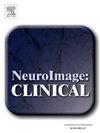Alterations of long-range association fibers in patients with anti-N-methyl-D-aspartate receptor encephalitis
IF 3.6
2区 医学
Q2 NEUROIMAGING
引用次数: 0
Abstract
Background
Patients with anti-NMDAR encephalitis typically exhibit impaired cognitive integration, which relies on the integrity of long-range association fibers connecting diverse brain regions. However, the microstructural integrity of long-range association fibers in this population remains unknown.
Methods
Diffusion tensor imaging (DTI) data were collected from 32 patients with anti-NMDAR encephalitis and 30 healthy controls. Patients were further categorized into early and delayed immunotherapy subgroups based on a 2-week threshold for immunotherapy initiation. The diffusion properties of major long-range association fibers were quantified at both the bundle and node levels.
Results
Compared with healthy controls, patients exhibited widespread microstructural damage within long-range association fibers, with more severe alterations in the delayed immunotherapy subgroup (FDR-corrected p < 0.05). In this subgroup(n = 14), radial diffusivity (RD) of left inferior fronto-occipital fasciculus (IFOF), left inferior longitudinal fasciculus (ILF), left superior longitudinal fascicles (SLF), and bilateral arcuate fascicles correlated significantly with global cognition (MMSE, FDR-corrected p < 0.05). Notably, RD also strongly correlated with working memory in the delayed immunotherapy subgroup, showing bundle-wise associations for IFOF (left: r = -0.8315, p = 0.0112; right: r = -0.7044, p = 0.0295), ILF (left: r = -0.7473, p = 0.0243), SLF (left: r = -0.7562, p = 0.0243; right: r = -0.6599, p = 0.0391), and arcuate fasciculus (left: r = -0.7240, p = 0.0272; right: r = -0.6835, p = 0.0333), with left-hemisphere predominance confirmed by node-wise analyses of IFOF, ILF, SLF, and arcuate fasciculus (FDR-corrected p < 0.05).
Conclusions
Our findings highlight widespread microstructural damage in long-range association fibers in patients with anti-NMDAR encephalitis, particularly in those with delayed immunotherapy. This damage may serve as the neurophysiological basis for cognitive impairments, with working memory being most affected.
抗n -甲基- d -天冬氨酸受体脑炎患者远端关联纤维的改变
抗nmdar脑炎患者通常表现为认知整合受损,这依赖于连接不同大脑区域的远端关联纤维的完整性。然而,在这个群体中,远端结缔组织纤维的显微结构完整性仍然是未知的。方法收集32例抗nmdar脑炎患者和30例健康对照者的弥散张量成像(DTI)数据。根据开始免疫治疗的2周阈值,将患者进一步分为早期和延迟免疫治疗亚组。在束和节点两个水平上量化了主要远程关联纤维的扩散特性。结果与健康对照组相比,患者在远端关联纤维中表现出广泛的微结构损伤,延迟免疫治疗亚组(fdr校正p <;0.05)。在该亚组(n = 14)中,左额枕下束(IFOF)、左下纵束(ILF)、左上纵束(SLF)和双侧弓状束的径向弥散性(RD)与整体认知(MMSE, fdr校正p <;0.05)。值得注意的是,在延迟免疫治疗亚组中,RD也与工作记忆密切相关,与IFOF呈束状相关(左:r = -0.8315, p = 0.0112;右:r = -0.7044, p = 0.0295),董继玲女士(左:r = -0.7473, p = 0.0243), SLF(左:r = -0.7562, p = 0.0243;右:r = -0.6599, p = 0.0391),弓形束(左:r = -0.7240, p = 0.0272;右:r = -0.6835, p = 0.0333), IFOF、ILF、SLF和弓形束的节点分析证实了左半球优势(fdr校正p <;0.05)。结论研究结果表明,抗nmdar脑炎患者,特别是延迟免疫治疗的患者,远端关联纤维广泛存在微结构损伤。这种损伤可能是认知障碍的神经生理学基础,其中工作记忆受到的影响最大。
本文章由计算机程序翻译,如有差异,请以英文原文为准。
求助全文
约1分钟内获得全文
求助全文
来源期刊

Neuroimage-Clinical
NEUROIMAGING-
CiteScore
7.50
自引率
4.80%
发文量
368
审稿时长
52 days
期刊介绍:
NeuroImage: Clinical, a journal of diseases, disorders and syndromes involving the Nervous System, provides a vehicle for communicating important advances in the study of abnormal structure-function relationships of the human nervous system based on imaging.
The focus of NeuroImage: Clinical is on defining changes to the brain associated with primary neurologic and psychiatric diseases and disorders of the nervous system as well as behavioral syndromes and developmental conditions. The main criterion for judging papers is the extent of scientific advancement in the understanding of the pathophysiologic mechanisms of diseases and disorders, in identification of functional models that link clinical signs and symptoms with brain function and in the creation of image based tools applicable to a broad range of clinical needs including diagnosis, monitoring and tracking of illness, predicting therapeutic response and development of new treatments. Papers dealing with structure and function in animal models will also be considered if they reveal mechanisms that can be readily translated to human conditions.
 求助内容:
求助内容: 应助结果提醒方式:
应助结果提醒方式:


